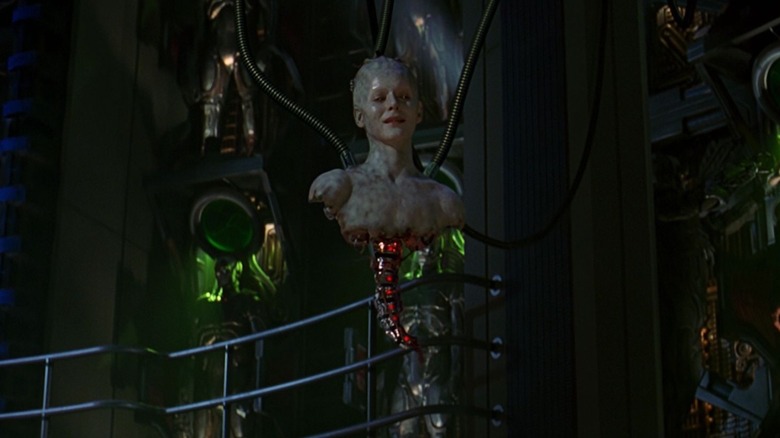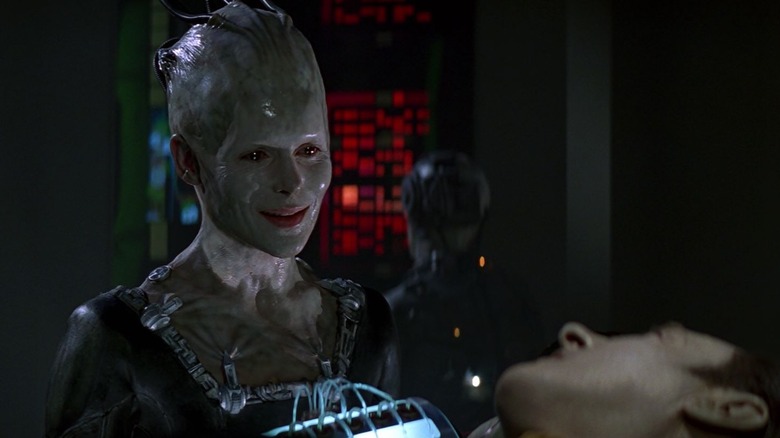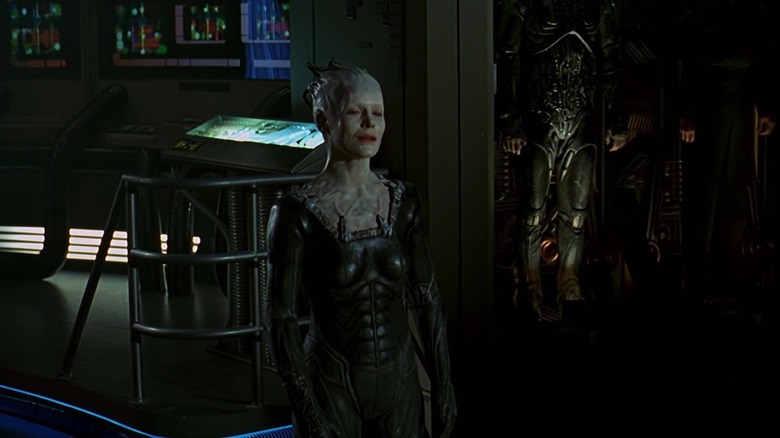One Borg Queen Stunt In Star Trek: First Contact Was Met With A Lot Of Doubt
About halfway through Jonathan Frake's 1996 sci-fi film "Star Trek: First Contact," Data (Brent Spiner) is being held hostage in the main engineering on board the U.S.S. Enterprise-E. Portions of the ship have been assimilated by the Borg, an invading race of emotionless cyborgs, and stone-faced drones march about the ship, infecting it with their transformative nanotechnology. Data has encountered the Borg on multiple occasions, however, and remains unflappable. He knows they are merely a collective consciousness, acting on a machine impulse to expand. There is no malevolence. Just programming.
Data, however — along with the Trekkies watching — is shocked to learn that the Borg have a leader. A partial humanoid torso — a head, shoulder, and little else — is lowered from the ceiling by tentacle-like tubes, its mechanical spinal cord hanging exposed. The shoulders are "plugged" into a waiting body below, and the Borg begins strutting around the room on its new legs. This is the Borg Queen (Alice Krige), an emotional, sensuous figure, different from the soulless machines we had previously known. She's more like a "Hellraiser" cenobite than Borg. Her introduction to Trek fundamentally altered all the franchise's subsequence depictions of the wicked cyborgs.
The "torso plugging" scene was difficult to pull off in 1996. CGI wasn't the default SFX technique of all major studio fantasy fare yet, so the filmmakers had to be resourceful. Behind-the-scenes photos reveal that both Krige and her stand-in Tracee Lee Cocco were live on set for the scene, partially draped with a blue blanket so their bodies could be photographically erased in post. In a 2016 oral history with the Hollywood Reporter, Cocco and Borg designer Todd Masters detailed the sequence's impressive marriage of CGI and practical effects, and how much skepticism there was about whether it would work or not.
Special effects of the late 1990s.
One might consider the late 1990s to be a golden age in special effects. CGI was an available tool, of course, but it was still too prohibitively expensive to rely on for everything. If CGI was used, judicious filmmakers had to employ it properly, careful to frame it and animate it in such a way that audiences could be dazzled by it. This was in addition to trick photography, creature sculpting, lighting, matte painting, makeup, and the myriad other tools already used by SFX technicians since the inception of the cinematic medium.
Designer Masters felt that everything was used just perfectly for the "torso plugging" shot, an imaginative creature scene not typically seen in films. He said:
"The whole part of the Queen coming down from the rafters when the head and shoulders are plugged into her body — that was unexpected at that time, the manner we approached it. Practical effects were still the rock star of the set, but CG was coming in. And we were one of the first groups to start integrating the two. So the whole thing with Alice coming down from the rafters and plugging in — most of the production didn't believe we could pull it off."
Masters felt that modern filmmaking would have broken up the scene too much. A lot of modern CGI sequences require actors to be alone in front of a green screen, and for each shot to be filmed according to availability. Reaction shots can be filmed months after the fact. "I didn't think it would have worked as well," Masters said, "if it was shot in two different parts, if we shot Data in month one and three months later we're shooting Alice on a blue screen."
The life of a stand-in
Cocco, meanwhile, needed to undergo the same physical trials that Krige did. Both actresses needed to have their heads attached to the prosthetic neck and shoulders, while their real bodies extended behind the makeup appliance, specially laid out on a plank-like structure. They then had to be actually, physically lowered down from the ceiling on a crane. Cocco said:
"They had me go up in a hoist on a flat kind of board and they turned the mechanism to make me turn over. And I'm so high and I'm afraid of heights anyway. Stand-ins have to do exactly what the actors do in every scene to get the lighting right."
Meanwhile, Masters also recalled how much brainstorming was required to pull the sequence off. Masters was wise enough to get as much of the sequence on film as possible, not wanting to rely on CGI in post. The body was animated by Industrial Light and Magic, George Lucas' celebrate VFX house. Enough attention was paid to the shot that, even 28 years later, the sequence looks amazing. Indeed, most of the effects in "First Contact" still look great. Master said:
"I really argued for shooting it all on one stage and no one knew what the hell I was talking about it. It was like, "Well how do we do that?" She doesn't have a body. We came up with this whole, bizarre system of old technology meets new — and it worked beautifully and ILM composited this thing together like gangbusters. And it's still shocking today. I have visual effects supervisors coming to me today asking how we did that shot."
A Queen was an odd idea to introduce to the Borg, but she was also a memorable, scary villain. She is beloved by many.


